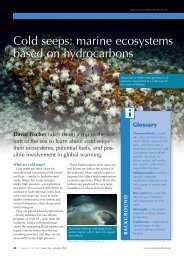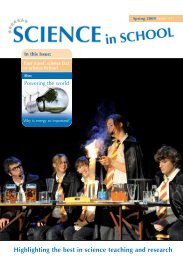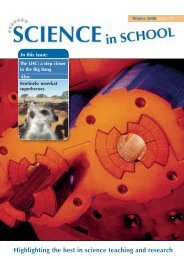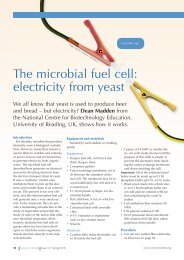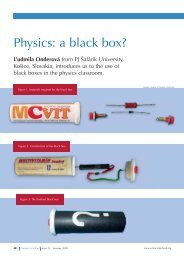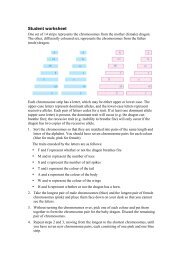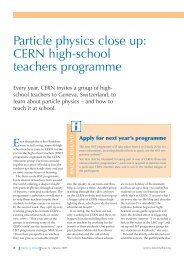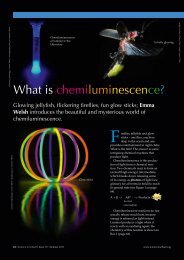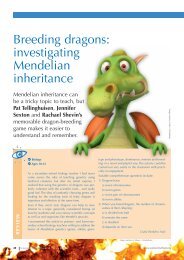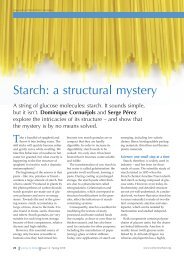Download Issue 14 as PDF [5.4 MB] - Science in School
Download Issue 14 as PDF [5.4 MB] - Science in School
Download Issue 14 as PDF [5.4 MB] - Science in School
You also want an ePaper? Increase the reach of your titles
YUMPU automatically turns print PDFs into web optimized ePapers that Google loves.
Image courtesy of ESO<br />
Three of the telescope domes of<br />
the Very Large Telescope<br />
dren’s curiosity to engage them with<br />
the world around them. And that is<br />
someth<strong>in</strong>g that – <strong>as</strong> part of the La<br />
ma<strong>in</strong> à la pâte project – we are able to<br />
help with (see box below).<br />
One l<strong>as</strong>t question: do you have a<br />
dream?<br />
Yes, but my dream is not only for<br />
Europe: we are wealthy <strong>in</strong> Europe,<br />
but I have visited schools <strong>in</strong> Africa<br />
and <strong>in</strong> Lat<strong>in</strong> America and seen the<br />
poverty. There are more than a hundred<br />
million children today who<br />
never go to school, and there are<br />
African schools with 120 children <strong>in</strong><br />
one cl<strong>as</strong>s. This is a very big problem.<br />
So if we succeed <strong>in</strong> build<strong>in</strong>g this<br />
European community of science education,<br />
we really have to share it with<br />
those countries; we have to help<br />
them, and also learn from them. The<br />
situation is bad, and climate change<br />
and overpopulation will make it<br />
worse. In a globalised world, we cannot<br />
just care for our own children. So<br />
my dream is that we build someth<strong>in</strong>g<br />
for Europe, but that we then share it.<br />
It’s not simple, but we can do it.<br />
Take Abdus Salam: he w<strong>as</strong> a physicist<br />
from Pakistan who won the 1979 Nobel<br />
Prize <strong>in</strong> Physics. His dream w<strong>as</strong> to foster<br />
research <strong>in</strong> develop<strong>in</strong>g countries. He<br />
conv<strong>in</strong>ced UNESCO, the Italian government,<br />
scientists and Nobel Prize<br />
w<strong>in</strong>ners to build a centre <strong>in</strong> Trieste,<br />
Italy, <strong>in</strong> 1964: the Inter national Centre<br />
for Theoretical Physics w2 . It w<strong>as</strong> to be<br />
a place to tra<strong>in</strong> scientists from devel-<br />
BACkGROund<br />
op<strong>in</strong>g countries to a high <strong>in</strong>ternational<br />
standard. The role this centre h<strong>as</strong><br />
played <strong>in</strong> chang<strong>in</strong>g research <strong>in</strong> those<br />
countries is <strong>in</strong>credible; it’s a simple<br />
idea and a remarkable model.<br />
La ma<strong>in</strong> à la pâte ide<strong>as</strong> have been<br />
extended to the Pollen project, <strong>in</strong><br />
which 12 ‘seed cities’ throughout<br />
Europe encouraged <strong>in</strong>quiry-b<strong>as</strong>ed<br />
science learn<strong>in</strong>g <strong>in</strong> primary schools<br />
(Lellouch & J<strong>as</strong>m<strong>in</strong>, 2009). With the<br />
follow-up Fibonacci project, started <strong>in</strong><br />
2010, the model will be extended to<br />
even more countries, <strong>in</strong>volv<strong>in</strong>g not<br />
only primary but also secondary<br />
schools, and not only science but also<br />
mathematics (see Léna, 2009). I th<strong>in</strong>k<br />
we should conv<strong>in</strong>ce the European<br />
Commission that we should also run<br />
a similar, dual project with, say, 12<br />
cities <strong>in</strong> Europe and 12 small towns <strong>in</strong><br />
Africa. I know it’s possible, because<br />
La ma<strong>in</strong> à la pâte is work<strong>in</strong>g with a<br />
school <strong>in</strong> Cameroon – and science<br />
education h<strong>as</strong> blossomed there.<br />
Nobody would have thought it possible,<br />
but we coached the teachers<br />
there, and it worked. Don’t forget –<br />
we’re dwarves stand<strong>in</strong>g on the shoulders<br />
of giants.<br />
Coach<strong>in</strong>g teachers <strong>in</strong> La ma<strong>in</strong><br />
à la pâte<br />
As part of the La ma<strong>in</strong> à la pâte project w3 , between 1500 and 2000 science<br />
or eng<strong>in</strong>eer<strong>in</strong>g students <strong>in</strong> France volunteer to help teachers use<br />
an <strong>in</strong>quiry-b<strong>as</strong>ed approach <strong>in</strong> the cl<strong>as</strong>sroom. For at le<strong>as</strong>t seven consecutive<br />
weeks, they spend half a day per week at a primary school,<br />
help<strong>in</strong>g the teacher prepare the lessons – f<strong>in</strong>d<strong>in</strong>g materials, prepar<strong>in</strong>g<br />
handouts, and sett<strong>in</strong>g up the experiments, <strong>as</strong> well <strong>as</strong> help<strong>in</strong>g with the<br />
scientific concepts and knowledge. The teacher rema<strong>in</strong>s <strong>in</strong> charge of<br />
the lesson, and the student supports both the teacher and the children<br />
throughout the <strong>in</strong>quiry process. Once the lesson is over, the student<br />
and teacher analyse it together. For more <strong>in</strong>formation, see Lellouch &<br />
J<strong>as</strong>m<strong>in</strong> (2009).<br />
<strong>14</strong> <strong>Science</strong> <strong>in</strong> <strong>School</strong> <strong>Issue</strong> <strong>14</strong> : Spr<strong>in</strong>g 2010<br />
www.science<strong>in</strong>school.org


![Download Issue 14 as PDF [5.4 MB] - Science in School](https://img.yumpu.com/26126440/16/500x640/download-issue-14-as-pdf-54-mb-science-in-school.jpg)


